KIA RIO HATCHBACK 2012 User Guide
Manufacturer: KIA, Model Year: 2012, Model line: RIO HATCHBACK, Model: KIA RIO HATCHBACK 2012Pages: 385, PDF Size: 9.68 MB
Page 11 of 385
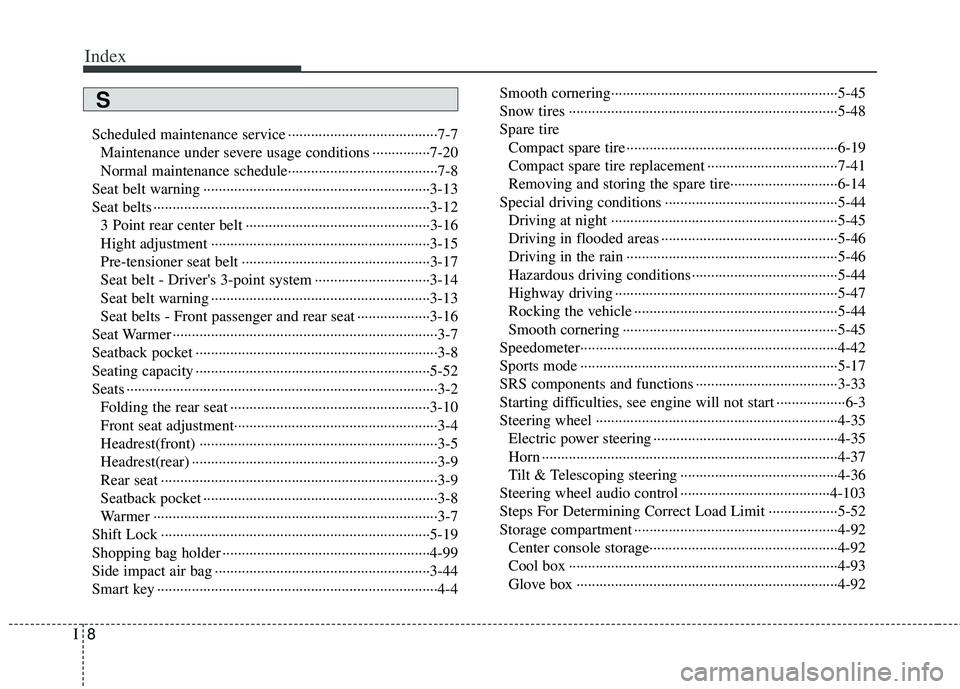
Index
8I
Scheduled maintenance service ··················\
··················\
···7-7Maintenance under severe usage conditions ···············7-20
Normal maintenance schedule··················\
··················\
···7-8
Seat belt warning ··················\
··················\
··················\
·····3-13
Seat belts ··················\
··················\
··················\
··················\
3-12 3 Point rear center belt ··················\
··················\
············3-16
Hight adjustment ··················\
··················\
··················\
···3-15
Pre-tensioner seat belt ··················\
··················\
·············3-17
Seat belt - Driver's 3-point system ··················\
············3-14
Seat belt warning ··················\
··················\
··················\
···3-13
Seat belts - Front passenger and rear seat ··················\
·3-16
Seat Warmer ··················\
··················\
··················\
···············3-7
Seatback pocket ··················\
··················\
··················\
·········3-8
Seating capacity ··················\
··················\
··················\
·······5-52
Seats ··················\
··················\
··················\
··················\
·········3-2 Folding the rear seat ··················\
··················\
················3-10
Front seat adjustment·············\
··················\
··················\
····3-4
Headrest(front) ··················\
··················\
··················\
········3-5
Headrest(rear) ··················\
··················\
··················\
··········3-9
Rear seat ··················\
··················\
··················\
··················\
3-9
Seatback pocket ··················\
··················\
··················\
·······3-8
Warmer ··················\
··················\
··················\
··················\
··3-7
Shift Lock ··················\
··················\
··················\
················5-19
Shopping bag holder ··················\
··················\
··················\
4-99
Side impact air bag ··················\
··················\
··················\
··3-44
Smart key ··················\
··················\
··················\
··················\
·4-4 Smooth cornering··················\
··················\
··················\
·····5-45
Snow tires ··················\
··················\
··················\
················5-48
Spare tire
Compact spare tire ··················\
··················\
··················\
·6-19
Compact spare tire replacement ··················\
················7-41
Removing and storing the spare tire···········\
·················6-14\
Special driving conditions ··················\
··················\
·········5-44 Driving at night ··················\
··················\
··················\
·····5-45
Driving in flooded areas ··················\
··················\
··········5-46
Driving in the rain ··················\
··················\
··················\
·5-46
Hazardous driving conditions ··················\
··················\
··5-44
Highway driving ··················\
··················\
··················\
····5-47
Rocking the vehicle ··················\
··················\
·················5-44\
Smooth cornering ··················\
··················\
··················\
··5-45
Speedometer··················\
··················\
··················\
·············4-42
Sports mode ··················\
··················\
··················\
·············5-17
SRS components and functions ··················\
··················\
·3-33
Starting difficulties, see engine will not start ··················\
6-3
Steering wheel ··················\
··················\
··················\
·········4-35 Electric power steering ··················\
··················\
············4-35
Horn ··················\
··················\
··················\
··················\
·····4-37
Tilt & Telescoping steering ··················\
··················\
·····4-36
Steering wheel audio control ··················\
··················\
···4-103
Steps For Determining Correct Load Limit ··················\
5-52
Storage compartment ··················\
··················\
·················4-92\
Center console storage·············\
··················\
··················\
4-92
Cool box ··················\
··················\
··················\
················4-93
Glove box ··················\
··················\
··················\
··············4-92
S
Page 12 of 385

I9
Index
Luggage net ··················\
··················\
··················\
···········4-93
Luggage tray ··················\
··················\
··················\
··········4-94
Sunroof··················\
··················\
··················\
··················\
···4-31
Sunvisor ··················\
··················\
··················\
··················\
·4-98
Tachometer··················\
··················\
··················\
···············4-42
Tailgate··················\
··················\
··················\
··················\
···4-20 Emergency safety release ··················\
··················\
········4-21
Telescoping steering ··················\
··················\
··················\
4-36
Tether anchor system ··················\
··················\
·················3-26\
Theft-alarm system ··················\
··················\
··················\
··4-12
Tie-down hook ··················\
··················\
··················\
·········6-30
Tilt steering ··················\
··················\
··················\
··············4-36
Tire and loading information label ··················\
··············5-51
Tire mobility kit ··················\
··················\
··················\
·······6-21
Tire pressure monitoring system (TPMS) ··················\
·····6-8
Tire specification and pressure label ··················\
·············8-8
Tires and wheels ··················\
··················\
··················\
7-37,8-4 Checking tire inflation pressure ··················\
················7-38
Compact spare tire replacement ··················\
················7-41
Recommended cold tire inflation pressures ················7-37
Tire care ··················\
··················\
··················\
·················7-37\
Tire maintenance ··················\
··················\
··················\
···7-42
Tire replacement ··················\
··················\
··················\
····7-41
Tire rotation ··················\
··················\
··················\
···········7-39
Tire sidewall labeling ··················\
··················\
··············7-42 Tire traction ··················\
··················\
··················\
···········7-42
Wheel alignment and tire balance ··················\
·············7-40
Wheel replacement ··················\
··················\
··················\
7-42
Towing ··················\
··················\
··················\
··················\
···6-27
Towing Tie-down hook ··················\
··················\
··················\
·······6-30
Towing capacity ··················\
··················\
··················\
·······5-52
Transaxle Automatic transaxle ··················\
··················\
·················5-15\
Manual transaxle ··················\
··················\
··················\
···5-12
Trip computer ··················\
··················\
··················\
··········4-45
User settings··················\
··················\
··················\
·············4-49
Vehicle break-in process ··················\
··················\
··············1-4
Vehicle capacity weight ··················\
··················\
·············5-51
Vehicle certification label ··················\
··················\
············8-7
Vehicle curb weight ··················\
··················\
··················\
·5-56
Vehicle identification number (VIN) ··················\
·············8-7
Vehicle load limit ··················\
··················\
··················\
·····5-51 Cargo capacity ··················\
··················\
··················\
·······5-52
Certification label ··················\
··················\
··················\
··5-54
Seating capacity ··················\
··················\
··················\
·····5-52
Steps For Determining Correct Load Limit ················5-52
T
U
V
Page 13 of 385
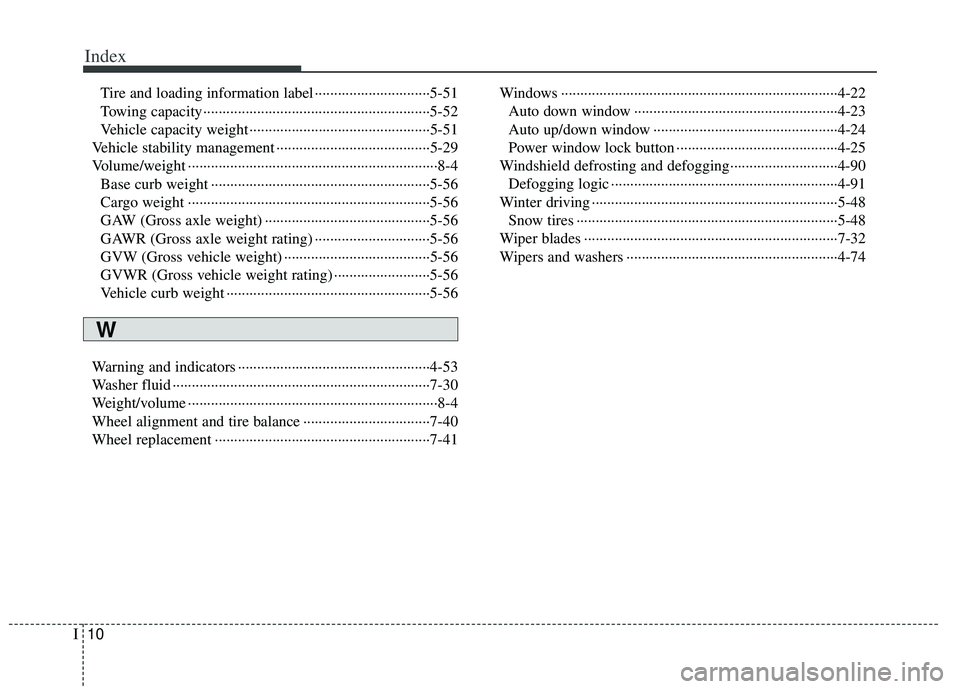
Index
10I
Tire and loading information label ··················\
············5-51
Towing capacity··················\
··················\
··················\
·····5-52
Vehicle capacity weight ··················\
··················\
···········5-51
Vehicle stability management ··················\
··················\
····5-29
Volume/weight ··················\
··················\
··················\
···········8-4 Base curb weight ··················\
··················\
··················\
···5-56
Cargo weight ··················\
··················\
··················\
·········5-56
GAW (Gross axle weight) ··················\
··················\
·······5-56
GAWR (Gross axle weight rating) ··················\
············5-56
GVW (Gross vehicle weight) ··················\
··················\
··5-56
GVWR (Gross vehicle weight rating) ··················\
·······5-56
Vehicle curb weight ··················\
··················\
·················5-56\
Warning and indicators ··················\
··················\
··············4-53
Washer fluid ··················\
··················\
··················\
·············7-30
Weight/volume ··················\
··················\
··················\
···········8-4
Wheel alignment and tire balance ··················\
···············7-40
Wheel replacement ··················\
··················\
··················\
··7-41 Windows ··················\
··················\
··················\
··················\
4-22
Auto down window ··················\
··················\
·················4-23\
Auto up/down window ··················\
··················\
············4-24
Power window lock button ··················\
··················\
······4-25
Windshield defrosting and defogging··················\
··········4-90 Defogging logic ··················\
··················\
··················\
·····4-91
Winter driving ··················\
··················\
··················\
··········5-48 Snow tires ··················\
··················\
··················\
··············5-48
Wiper blades ··················\
··················\
··················\
············7-32
Wipers and washers ··················\
··················\
··················\
·4-74
W
Page 14 of 385
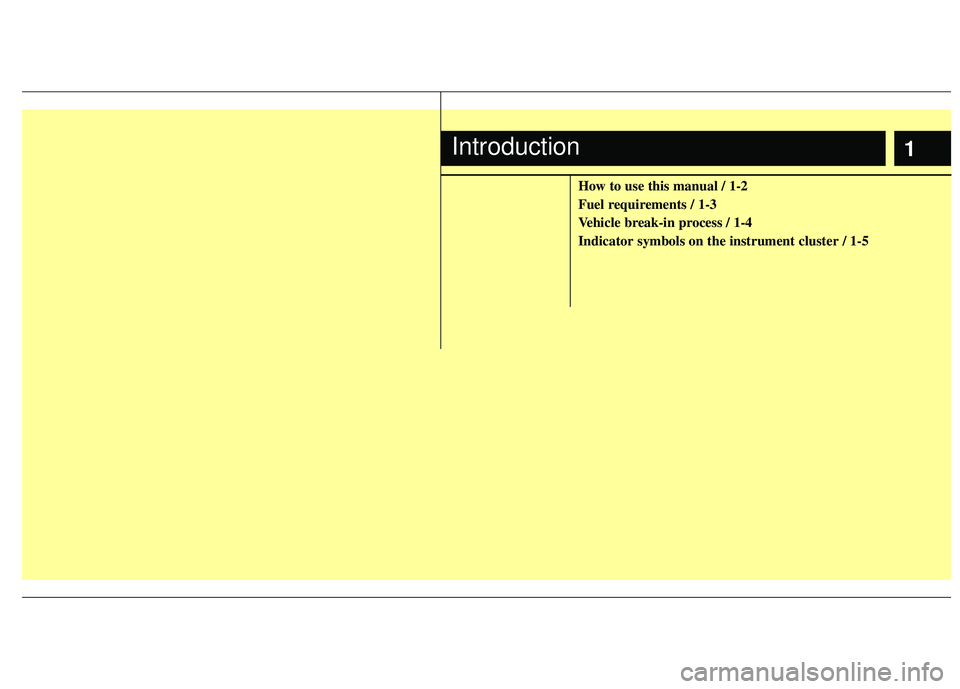
1
How to use this manual / 1-2
Fuel requirements / 1-3
Vehicle break-in process / 1-4
Indicator symbols on the instrument cluster / 1-5
Introduction
Page 15 of 385
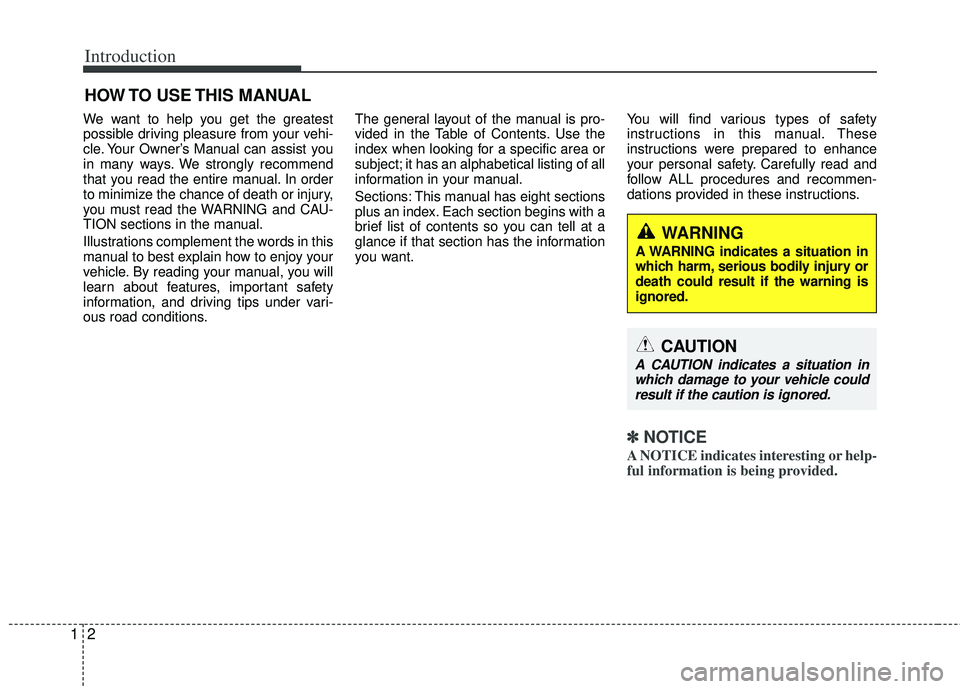
Introduction
21
We want to help you get the greatest
possible driving pleasure from your vehi-
cle. Your Owner’s Manual can assist you
in many ways. We strongly recommend
that you read the entire manual. In order
to minimize the chance of death or injury,
you must read the WARNING and CAU-
TION sections in the manual.
Illustrations complement the words in this
manual to best explain how to enjoy your
vehicle. By reading your manual, you will
learn about features, important safety
information, and driving tips under vari-
ous road conditions.The general layout of the manual is pro-
vided in the Table of Contents. Use the
index when looking for a specific area or
subject; it has an alphabetical listing of all
information in your manual.
Sections: This manual has eight sections
plus an index. Each section begins with a
brief list of contents so you can tell at a
glance if that section has the information
you want.
You will find various types of safety
instructions in this manual. These
instructions were prepared to enhance
your personal safety. Carefully read and
follow ALL procedures and recommen-
dations provided in these instructions.
✽ ✽
NOTICE
A NOTICE indicates interesting or help-
ful information is being provided.
HOW TO USE THIS MANUAL
WARNING
A WARNING indicates a situation in
which harm, serious bodily injury or
death could result if the warning is
ignored.
CAUTION
A CAUTION indicates a situation in
which damage to your vehicle couldresult if the caution is ignored.
Page 16 of 385
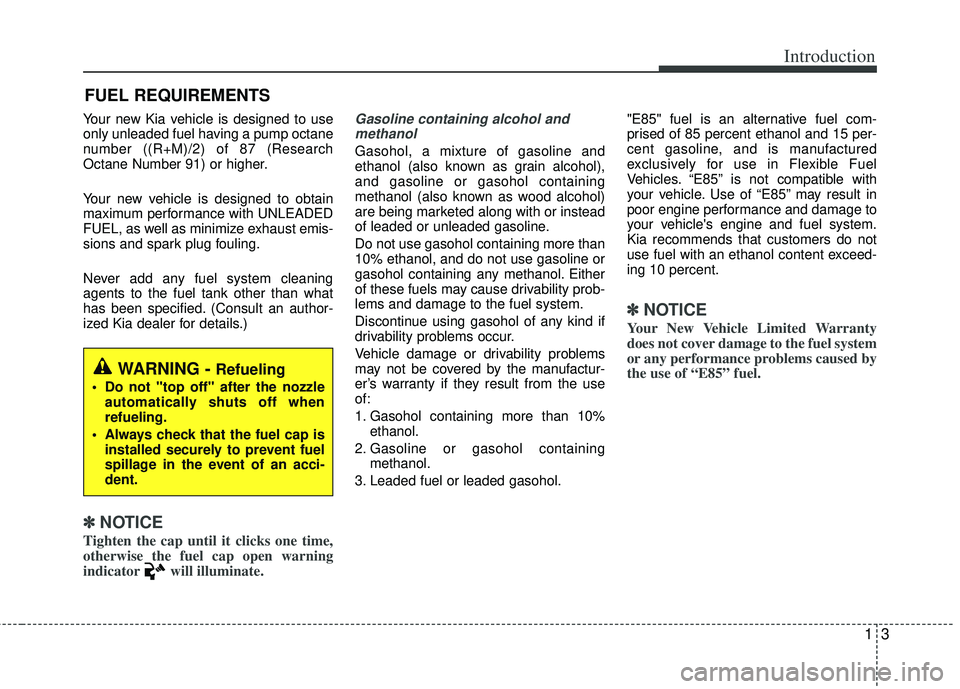
13
Introduction
Your new Kia vehicle is designed to use
only unleaded fuel having a pump octane
number ((R+M)/2) of 87 (Research
Octane Number 91) or higher.
Your new vehicle is designed to obtain
maximum performance with UNLEADED
FUEL, as well as minimize exhaust emis-
sions and spark plug fouling.
Never add any fuel system cleaning
agents to the fuel tank other than what
has been specified. (Consult an author-
ized Kia dealer for details.)
✽ ✽
NOTICE
Tighten the cap until it clicks one time,
otherwise the fuel cap open warning
indicator will illuminate.
Gasoline containing alcohol and
methanol
Gasohol, a mixture of gasoline and
ethanol (also known as grain alcohol),
and gasoline or gasohol containing
methanol (also known as wood alcohol)
are being marketed along with or instead
of leaded or unleaded gasoline.
Do not use gasohol containing more than
10% ethanol, and do not use gasoline or
gasohol containing any methanol. Either
of these fuels may cause drivability prob-
lems and damage to the fuel system.
Discontinue using gasohol of any kind if
drivability problems occur.
Vehicle damage or drivability problems
may not be covered by the manufactur-
er’s warranty if they result from the use
of:
1. Gasohol containing more than 10% ethanol.
2. Gasoline or gasohol containing methanol.
3. Leaded fuel or leaded gasohol. "E85" fuel is an alternative fuel com-
prised of 85 percent ethanol and 15 per-
cent gasoline, and is manufactured
exclusively for use in Flexible Fuel
Vehicles. “E85” is not compatible with
your vehicle. Use of “E85” may result in
poor engine performance and damage to
your vehicle's engine and fuel system.
Kia recommends that customers do not
use fuel with an ethanol content exceed-
ing 10 percent.
✽ ✽
NOTICE
Your New Vehicle Limited Warranty
does not cover damage to the fuel system
or any performance problems caused by
the use of “E85” fuel.
FUEL REQUIREMENTS
WARNING - Refueling
• Do not "top off" after the nozzle
automatically shuts off when
refueling.
Always check that the fuel cap is installed securely to prevent fuel
spillage in the event of an acci-
dent.
Page 17 of 385
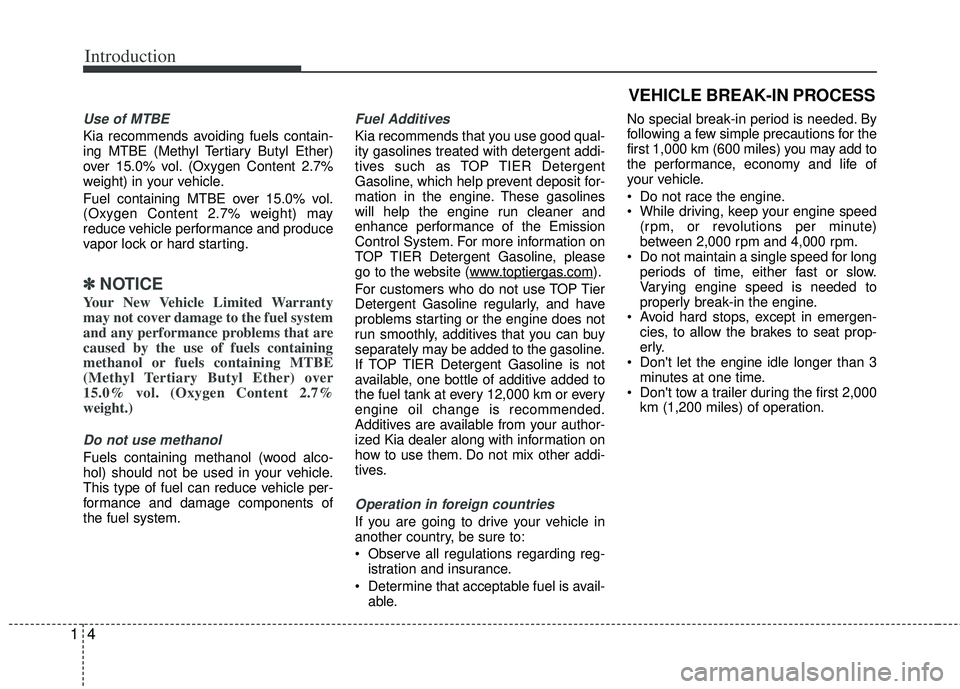
Introduction
41
Use of MTBE
Kia recommends avoiding fuels contain-
ing MTBE (Methyl Tertiary Butyl Ether)
over 15.0% vol. (Oxygen Content 2.7%
weight) in your vehicle.
Fuel containing MTBE over 15.0% vol.
(Oxygen Content 2.7% weight) may
reduce vehicle performance and produce
vapor lock or hard starting.
✽ ✽
NOTICE
Your New Vehicle Limited Warranty
may not cover damage to the fuel system
and any performance problems that are
caused by the use of fuels containing
methanol or fuels containing MTBE
(Methyl Tertiary Butyl Ether) over
15.0% vol. (Oxygen Content 2.7%
weight.)
Do not use methanol
Fuels containing methanol (wood alco-
hol) should not be used in your vehicle.
This type of fuel can reduce vehicle per-
formance and damage components of
the fuel system.
Fuel Additives
Kia recommends that you use good qual-
ity gasolines treated with detergent addi-
tives such as TOP TIER Detergent
Gasoline, which help prevent deposit for-
mation in the engine. These gasolines
will help the engine run cleaner and
enhance performance of the Emission
Control System. For more information on
TOP TIER Detergent Gasoline, please
go to the website (www
.toptiergas.com).
For customers who do not use TOP Tier
Detergent Gasoline regularly, and have
problems starting or the engine does not
run smoothly, additives that you can buy
separately may be added to the gasoline.
If TOP TIER Detergent Gasoline is not
available, one bottle of additive added to
the fuel tank at every 12,000 km or every
engine oil change is recommended.
Additives are available from your author-
ized Kia dealer along with information on
how to use them. Do not mix other addi-
tives.
Operation in foreign countries
If you are going to drive your vehicle in
another country, be sure to:
Observe all regulations regarding reg- istration and insurance.
Determine that acceptable fuel is avail- able. No special break-in period is needed. By
following a few simple precautions for the
first 1,000 km (600 miles) you may add to
the performance, economy and life of
your vehicle.
Do not race the engine.
While driving, keep your engine speed
(rpm, or revolutions per minute)
between 2,000 rpm and 4,000 rpm.
Do not maintain a single speed for long periods of time, either fast or slow.
Varying engine speed is needed to
properly break-in the engine.
Avoid hard stops, except in emergen- cies, to allow the brakes to seat prop-
erly.
Don't let the engine idle longer than 3 minutes at one time.
Don't tow a trailer during the first 2,000 km (1,200 miles) of operation.
VEHICLE BREAK-IN PROCESS
Page 18 of 385

15
Introduction
INDICATOR SYMBOLS ON THE INSTRUMENT CLUSTER
Seat belt warning light
High beam indicator
Turn signal indicator
ABS warning light
Parking brake & Brake fluid
warning light
Engine oil pressure warning light
ESC indicator
ESC OFF indicator
Malfunction indicator light
Air bag warning light
Immobilizer indicator
Low fuel level warning light* : if equipped
Charging system warning light
Tail light indicator
Tailgate open ajar warning light
Front fog light indicator*
Electric power steering (EPS)
system warning light*Door ajar warning light
Shift pattern indicator*
Manual transaxle shift indicator* Key out warning light*
KEY
OUT
ECO indicator*ECO
Auto stop for ISG system
indicator*
Low beam indicator
Engine coolant temperature
warning light*
❈For more detailed explanations, refer to “Instrument cluster” in section 4. Low tire pressure telltale* /
TPMS malfunction indicator*
Cruise SET indicator*
Cruise control indicator*
CRUISE
Fuel cap open warning indicator
Page 19 of 385

2
Interior overview / 2-2
Instrument panel overview / 2-3
Engine compartment / 2-4
Your vehicle at a glance
Page 20 of 385
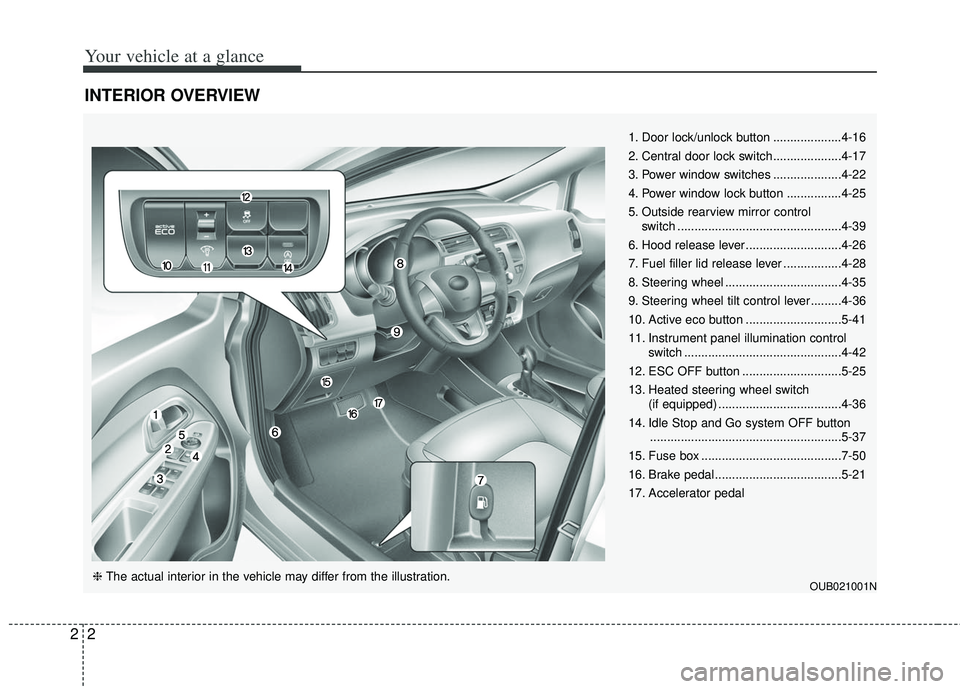
Your vehicle at a glance
22
INTERIOR OVERVIEW
OUB021001N
1. Door lock/unlock button ....................4-16
2. Central door lock switch....................4-17
3. Power window switches ....................4-22
4. Power window lock button ................4-25
5. Outside rearview mirror control switch ................................................4-39
6. Hood release lever ............................4-26
7. Fuel filler lid release lever .................4-28
8. Steering wheel ..................................4-35
9. Steering wheel tilt control lever.........4-36
10. Active eco button ............................5-41
11. Instrument panel illumination control switch ..............................................4-42
12. ESC OFF button .............................5-25
13. Heated steering wheel switch (if equipped) ....................................4-36
14. Idle Stop and Go system OFF button ........................................................5-37
15. Fuse box .........................................7-50
16. Brake pedal .....................................5-21
17. Accelerator pedal
❈ The actual interior in the vehicle may differ from the illustration.